一 : 高一英语Lesson 59教学设计方案
Step I Watching the video
Step II Listening and answer
1)What opened on Wang Fujing Street in 1992?
2) Why do many Westerners die at an early age from heart illnesses?
Key: 1) A new hamburger restaurant opened on Wang Fujing Street in 1992.
2) Because they always eat food that is high in fat, sugar and salt.
Step III Language points:
Go through the text words, explain any difficult language points.
1.scores of people: a lot of people
2.not good value for money: not worth the high price
3.are high in fat :contain a large a mount of fat
4.weight problems : become too heavy
5. eight pieces of sugar: sugar here means cube sugar
6. Coca Cola: the brand name of one kind of cola.
Step IV Practice
Lesson 59,Part2, Do the first part with the whole CLASs. Ask them to go back to the two passages again if they have difficulty giving you the answers:
Which food you think is healthy and which is unhealthy?
Hamburger/fruit /Coca Cola/chocolate/ peas/cakes/cream/cabbage/nuts/fried cakes.
Healthy foods: fruit, peas, cabbage, nuts.
Unhealthy foods: hamburger, Coca Cola, chocolate, cakes, cream.
Do an example of the dialogue with the whole CLASs, then let the Ss work in pairs. Get some pairs to act out their dialogue.
Step V Discussion
Lesson 59 Part3.Revise the language of discussions first: What do you think? In my opinion….; I agree/don’t agree, etc. Then let the Ss work in pairs. Finally hold a CLASs discussion. For example:
A: Why do people go to hamburger restaurants?
B: In my opinion. You can eat something quickly.
A: I agree.
Step VI Homework
Finish the Workbook exercises.
Combine with Lesson 58 and Lesson 59, ask the Ss to retell them
二 : 关于德育教育高中英语教学设计
**中学关于德育的高中英语教学设计
[www.61k.com)课题:人教版 必修四Unit 4 Body Language
Reading: Communication: No Problem?
一:指导思想与理论依据
将自己在本节课教学中的亮点设计所依据的指导思想或者核心教育教学理论简述即可,指导思想和依据的教育理论应该在后面的教学过程中明确体现出来。本部分内容必须和实际的教学内容紧密联系,避免出现照搬课标中整个模块的教学指导思想等情况。提倡精讲多练的课堂教学模式,以学生为主体,让学生发挥主体作用,让学生通过讨论自己解决问题,老师只加以引导。整堂课以激发学生兴趣为原则,通过图片导入,略读,精读,小组讨论等环节帮助学生了解不同国家的文化知识背景,了解身势语在人们日常生活中的作用。
二:教材分析
课标中对本节内容的要求;本节内容的知识体系;本节内容在教材中的地位,前后教材内容的逻辑关系。
本节核心内容的功能和价值(为什么学本节内容),不仅要思考其他内容对本节内容学习的帮助,本节内容的学习对学科体系的建立、其他学科内容学习的帮助;还应该思考通过本节内容的学习,对学生学科能力甚至综合素质的帮助,以及思维方式的变化影响等。
本单元以身势语为中心话题,其中本节阅读课主要为学生提供了来自不同国度、不同语言文化背景的身势语及其在交际中的异同和影响的具体例证。通过课文内容可以让学生正确认识和掌握身势语在交际中的作用和意义,使学生明确身势语在人类交际中的重要性,了解身势语在不同民族、不同文化交际中的多样性;使学生在今后的日常生活、学习、工作和交往中尽量减少或避免运用身势语时可能产生的误解,提高他们的“语言交际”能力和“非语言交际”能力。
三:学情分析
教师主观分析、师生访谈、学生作业或试题分析反馈、问卷调查等是比较有效的学习者分析的测量手段。
学生认知发展分析:主要分析学生现在的认知基础(包括知识基础和能力基础),要形成本节内容应该要走的认知发展线,即从学生现有的认知基础,经过哪几个环节,最终形成本节课要达到的知识。
学生认知障碍点:学生形成本节课知识时最主要的障碍点,可能是知识基础不足、旧的概念或者能力方法不够、思维方式变化等。
学生对身势语这一话题比较感兴趣,也很想了解课文的内容,这对于课文的展开是有利的。但对于阅读具体步骤要求还是显得不够积极,所以很有必要在课上激发他们的兴趣,让他们多讨论,发挥合作探究精神,发挥主体作用。
四:教学目标
①知识与技能:了解不同国家身势语的文化差异。
②过程与方法:在阅读训练中渗透略读,精读等技巧,让学生进行小组讨论,积极回答问题。
③情感态度与价值观:身势语在人们日常交际和生活当中起着很重要的作用。
五:教学重点和难点
①了解不同文化中的身势语的不同含义,掌握阅读技巧。
②了解不同文化中的身势语可以防止跨文化交际中产生误解。
六:教学过程
Step I Lead-in
Question: Go through the pictures in the warming up and discuss what are these people communicating?(利用问题及图片导入话题,激发学生的兴趣,引入课文话题)。
Step II Pre-reading
Look at the title and picture in the reading passage. Predict the topic of the passage. (让学生预测课文内容,引起学生阅读课文的兴趣)。
Step III Reading
1.Skimming: Skim the passage and answer the questions on page27.(通过问题设置,让学生进一步了解文章内容)。
2.Careful reading: Read the passage carefully and finish the chart on page27.(表格设置可以让学生获取文章细节信息)。
Step IV Discussion(Comprehending)
Choose one question and have a discussion about comprehending Ex3.(课后问题的设置基于课文内容,让学生进行小组讨论,锻炼学生发散性思维)。
Step V Summary
What can we learn from the passage? (这一问题的设置可以帮助学生归纳总结文章内容并渗透了德育教育)。
Step VI Homework
1. Read the text again and underline some important phrases and sentences.
2. Retell the whole passage with the help of the Ex.1 in the comprehending part.(锻炼学生的概括和总结课文的能力)。
三 : 高中英语教学设计模板
课时教学设计

高中英语教学设计 高中英语教学设计模板
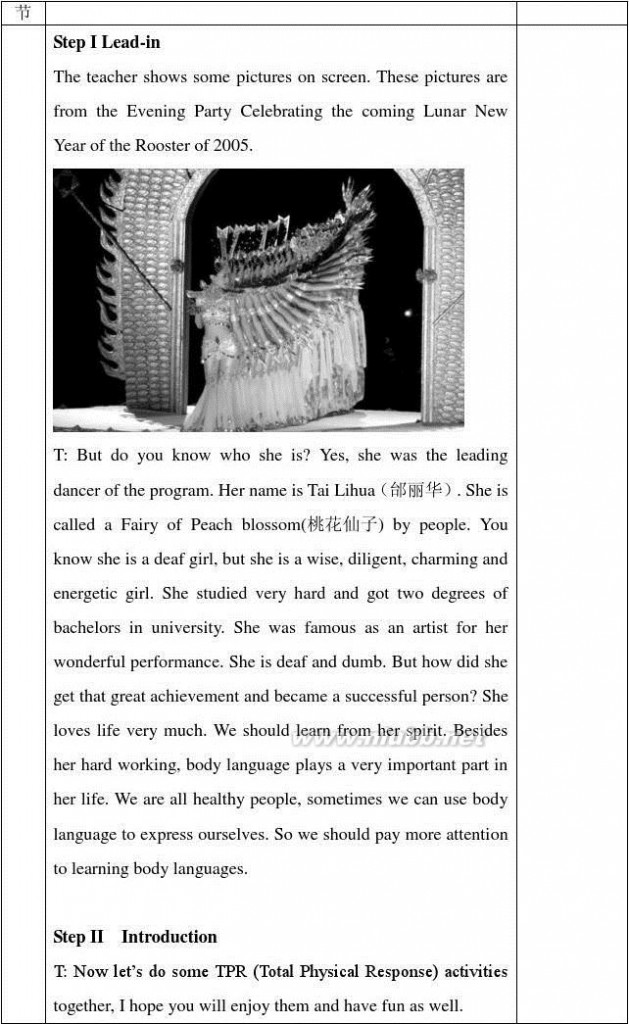
高中英语教学设计 高中英语教学设计模板
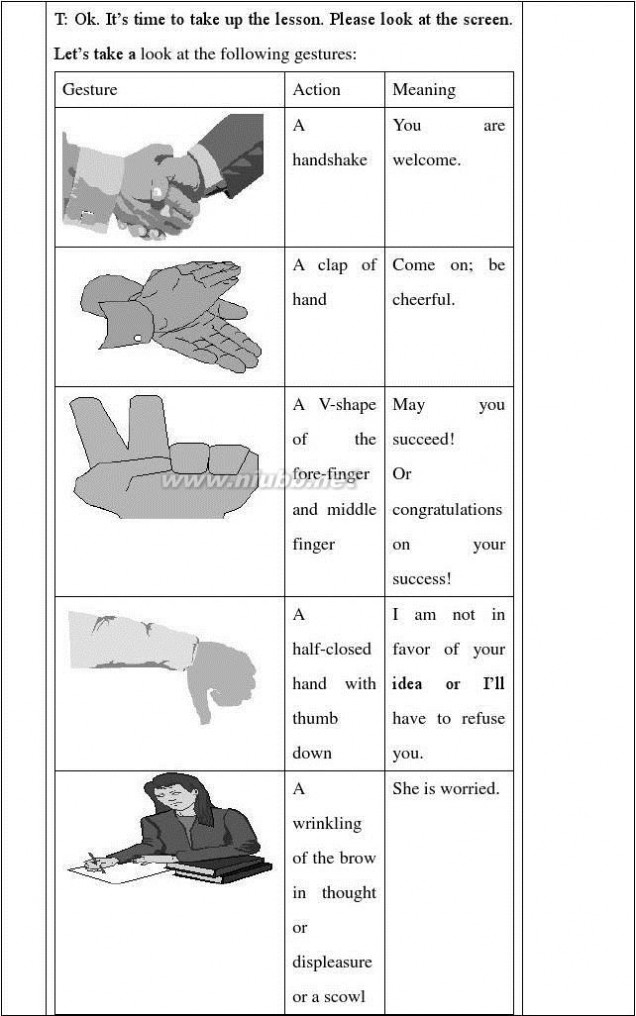
高中英语教学设计 高中英语教学设计模板

高中英语教学设计 高中英语教学设计模板
课时教学设计
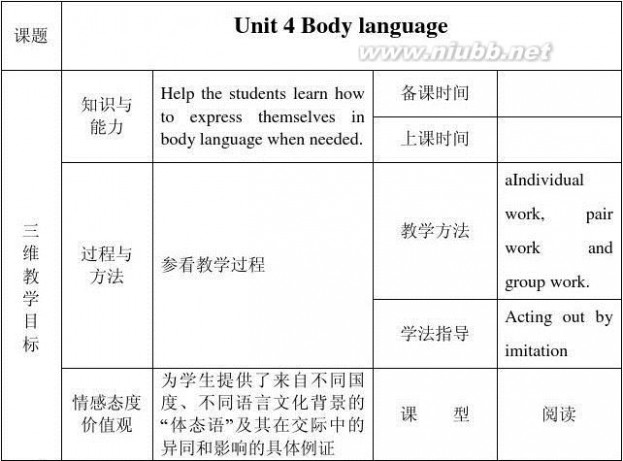
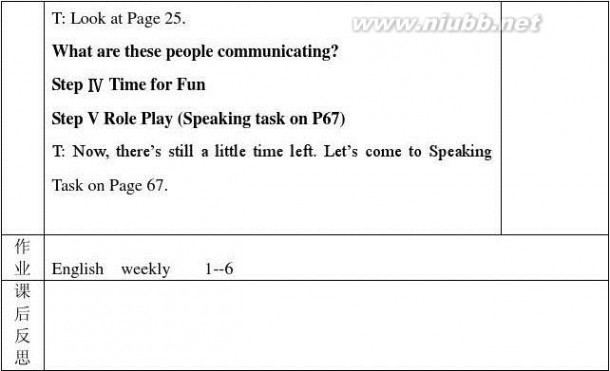
高中英语教学设计 高中英语教学设计模板
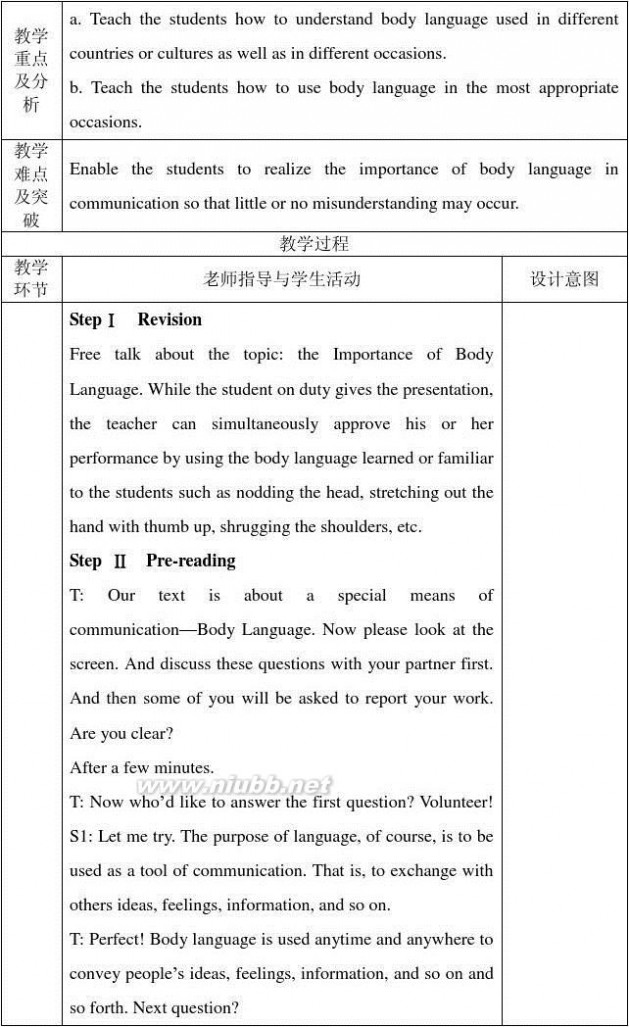
高中英语教学设计 高中英语教学设计模板
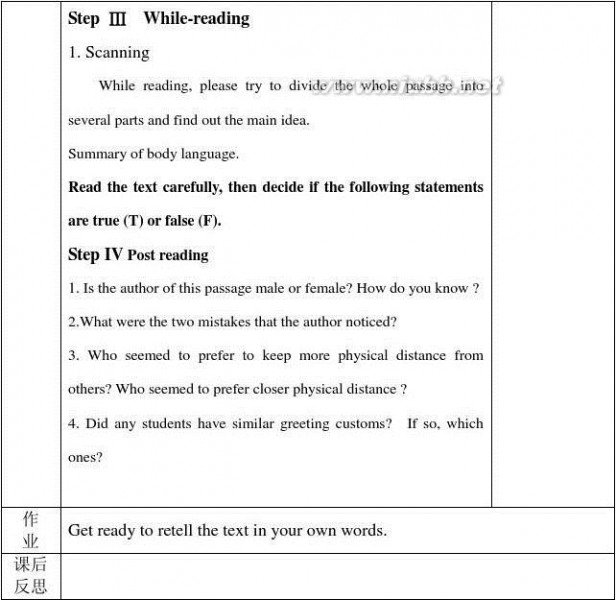
高中英语教学设计 高中英语教学设计模板
课时教学设计
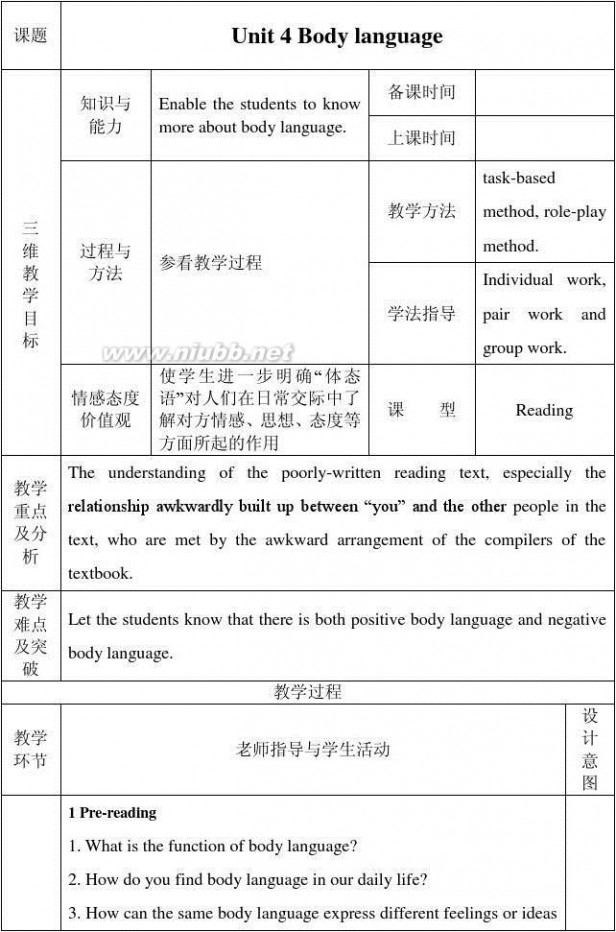
高中英语教学设计 高中英语教学设计模板

高中英语教学设计 高中英语教学设计模板
课时教学设计


高中英语教学设计 高中英语教学设计模板

四 : 高一英语 New Zealand 教学设计 Period 1
Unit 18 New ZealandPeriod 1
(一)明确目标
1. Learn the useful expressions to talk about location and direction.
2. Have listening practice.
(二)整体感知
Step 1
Show the students a map of china and ask them to find out several places and tell the others the location of these places.
(三)教学过程
Step 2 warming up
Get eh students to look at the map of china and names of countries, islands and seas beyond China, Divide the students into groups of four and talk about the positions of the different places and waters in relation to china.
Step 3 listening
Ask the students to look at the map on page 37.this is the map of Dolphin island. Play the tape for the first time for the students to finish exercise 1. Play the tape again. This time the students are required to do Exercise 2.
Step 4 Speaking
The teacher asks one of the students “where are you from?” “Can you tell me the position of your hometown?” encourage the students to use “in the north/south/east/west of” or “to the north/south/east/west of “
Read the example dialogue. Then get the students to talk about the birthplaces of their grandparents. Parents and them selves in pairs. At the edn ask one or two pairs to act out their dialogues in front of the class.
(四)总结、扩展
Step 5
Finish off the exercises in workbook.
(五)随堂练习
1)用适当的介词填空:
1. He lives in a town ____ the east coast.
2. Hainan Island id ____ the south of Guangdong province.
3. Henan province lie _____ central china.
4. The ship hi t rock ___ the west coast of the pacific:
2)将下了句子译成英语。
1. 我父亲出生在这个城市以西30公里处的一个小村庄。
2. 我来自安庆,安徽西南部的一个小城市。
3. 安徽省位于江苏省的西边,河北省的南边。
参考答案:
1)1. on 2. to 3. in 4. off
2) 1. my father was born in a small village, which is about 30 kilometers west of this city.
2. I’m from Anqing a small city in southwestern Anhui province.
3. Anhui province lies on the west of Jiangsu, but to the south of Hebei.
本文标题:高中英语教学设计-高一英语Lesson 59教学设计方案61阅读| 精彩专题| 最新文章| 热门文章| 苏ICP备13036349号-1